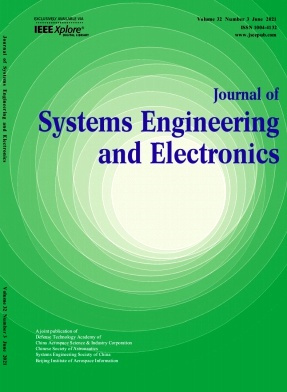
Journal of Systems Engineering and Electronics投稿地址
Journal of Systems Engineering and Electronics詳細信息
Journal of Systems Engineering and Electronics
Journal of Systems Engineering and Electronics
Journal of Systems Engineering and Electronics投稿要求
Journal of Systems Engineering and Electronics雜志投稿須知:Aims and scopeThe journal, keeping abreast with the development trend of science and technology worldwide, reports the latest developments and achievements in systems engineering and electronics and related research areas, and encourages various academic views. The journal welcomes papers from a wide variety of countries.The journal strives to publish high-quality papers reporting original work in both theoretical and practical research results within the journal scope, involving system analysis, system modeling and simulation, military system analysis, aircraft control, C3I, radar, information systems engineering, machine intelligence, artificial neural networks, information acquisition and processing, aerospace electronics, and other topics in all related fields.TitleThe title is centered on the page and should be short and concise. Please limit the title to a maximum length of 10 words. The author’s name follows and is also centered on the page. The author’s last name should be preceded by the other names spelled out in full. The author’s affiliation and address are also needed.The corresponding author should be clearly indicated with the asterisk (i.e., *) and given on the bottom of the first page. Please provide the financial support acknowledgments (name and number) on the bottom of the first page.AbstractAn abstract, not exceeding 200 words, is required for all papers. Acronyms and abbreviations are spelled out at first mention in the abstract. It should be a summary of the paper and not an introduction. Because the abstract may be used in abstracting journals, it should present concisely the purposes, methodology used, results obtained, and conclusions.KeywordsThe author must provide a list of keywords, up to a maximum of six. No acronyms and abbreviations should be used.TextText should be typed in double-column. The introduction of paper should explain the nature of the problem, previous work, purpose, and contribution of the paper. It is assigned the number “1” and following sections are assigned number as needed. For example, the third section of a paper might be “3. Simulation results” headings. Acronyms and abbreviations are spelled out at first mention in the text, even they have already been defined in the abstract.Figures and tablesThe authors must ensure figures of sufficient quality and resolution. Figure captions appear below the figures. Figures should be numbered in the order they appear in the text. Table titles appear above the tables. Please verify that the figures and tables you mention in the text actually exist. When referring to a figure or a table in the text, use the abbreviation “Fig.” even at the beginning of a sentence, and do not abbreviate “Table”.EquationsNumber equations consecutively with equation numbers in parentheses flush with the right margin, as in (1). Be sure that the symbols in the equation have been defined before the equation appears or immediately following. When referring to “(1)”, do not use “Eq. (1)” or “equation (1),” except at the beginning of a sentence: “Equation (1) is ...”.ConclusionA conclusion must be included and should indicate clearly the advantages, limitations, and possible applications of the paper.AcknowledgmentIndividuals or units other than authors who were of direct help in the work should be acknowledged by a brief statement following the conclusion. This heading is not assigned a number.ReferencesOnly articles that have been published may be included in the references. Each reference is referred to in the text by a number enclosed in a square bracket (i.e., [3]). References must be numbered and ordered according to where they are first mentioned in the paper. A reference list must be included using the following information as a guide.BiographiesShort biographies (120-150 words) should be provided that detail the authors’ education, work histories and research interests as well as their E-mail. The authors’ full names are needed. Small (2.5 cm×3.5 cm), black-and-white and high- resolution (300 dpi) photos of each author should be included.
Journal of Systems Engineering and Electronics雜志簡介
《Journal of Systems Engineering and Electronics》是《中國科學引文數(shù)據(jù)庫》來源期刊,被美國科學引文索引(SCIE)、美國工程索引(EI)和英國科學文摘(SA)等多家國內、外著名檢索系統(tǒng)收錄。
《Journal of Systems Engineering and Electronics》是面向高科技開發(fā)和應用的跨學科期刊,以傳播新技術、促進學術交流為宗旨,堅持深度與廣度、理論與應用相結合的方針,努力反映系統(tǒng)工程與電子技術兩大領域的最新成就,報道的主要內容包括:系統(tǒng)科學、軍事系統(tǒng)分析、飛行器控制、雷達、光電探測技術、信息獲取與處理、運籌學管理與決策技術等。
Journal of Systems Engineering and Electronics統(tǒng)計分析
影響因子:指該期刊近兩年文獻的平均被引用率,即該期刊前兩年論文在評價當年每篇論文被引用的平均次數(shù)
被引半衰期:衡量期刊老化速度快慢的一種指標,指某一期刊論文在某年被引用的全部次數(shù)中,較新的一半被引論文刊載的時間跨度
他引率:期刊被他刊引用的次數(shù)占該刊總被引次數(shù)的比例用以測度某期刊學術交流的廣度、專業(yè)面的寬窄以及學科的交叉程度
引用半衰期:指某種期刊在某年中所引用的全部參考文獻中較新的一半是在最近多少年時段內刊載的
平均引文數(shù):在給定的時間內,期刊篇均參考文獻量,用以測度期刊的平均引文水平,考察期刊吸收信息的能力以及科學交流程度的高低
熱門評論
收稿后很快過了初審,交了審稿費就送外審了。兩個審稿人,一個僅用了二十天左右的時候就返回了意見,另一個審了約一個半月,按要求認真修改以后,又過了一周左右,然后直接錄用了。
都說終審比較快,結果我又比較悲催,終審了半個月不見回復,按耐不住,發(fā)了個郵件詢問編輯,編輯回復副主編可能是比較忙,耐心等待。結果發(fā)了郵件后三天,就收到了錄用通知。真是驚喜。
Journal of Systems Engineering and Electronics雜志工作效率還是很高的,編輯相當認真負責,我論文中的參考文獻并不是按照出現(xiàn)的先后順序標注的,但是在出版稿中他幫我全部修改了。而且還包括了一部分筆誤造成的語言錯誤。非常細致,推薦大家投這個雜志!
期刊是不錯的期刊,審稿很慢!回復也很慢!出刊也很慢,壓個1半載很正常;投稿一個月后,收到改后再審,審了3個月沒消息,發(fā)郵件石沉大海;等著畢業(yè)的通知慎重考慮。總體來說還是很不錯的哦。
同事介紹的這本雜志,周末時鼓起勇氣投了一篇Journal of Systems Engineering and Electronics雜志,準備4個月給一審結果就不錯了,投稿三天了一點反應沒有,還是新到稿件,編輯真不知道忙什么呢,快點送審就好了,期盼能遇到好的審稿人~
挺好的一雜志,Journal of Systems Engineering and Electronics雜志編輯很耐心,修改意見也很中肯,是個值得投的期刊。見刊也很快呀,從投稿到見刊3個月。編輯真的很負責任,從審核到最后的發(fā)表,一直跟蹤到底,而且態(tài)度很好。
末投了一篇,三個月左右出結果,一個拒稿,一個小修,編輯讓大修,一個月后返回,寫了長長的反駁意見,二周左右接收,還是很意外加+驚喜的。
從投稿到正式錄用大概2個月,6月份投稿的,8月20多號錄用,投稿后一個月專家給了審稿意見,小修了一次,審稿速度算比較快的。這是我第一篇錄用的文章,還是比較開心的。但是發(fā)稿還是比較慢的。
在投稿網(wǎng)已經(jīng)訂了一雜志了,雜志質量很好,總體上還是很滿意的。內容豐富,發(fā)貨也還是比較及時的,也很正規(guī),客服服務也還不錯,物流也給力,到貨及時,包裝良好,值得信賴,加油。
Journal of Systems Engineering and Electronics雜志的文章要點很直接,很簡要的。適合大學畢業(yè)做畢業(yè)論文的指導用書。現(xiàn)在大學生或研究生都不自己讀書,而是要導師“告訴怎么做”,實際上,找?guī)妆局笇纯锤靼住K允淄仆陡寰W(wǎng)的書。
相關問題
- Journal of Systems Engineering and Electronics是正規(guī)期刊嗎?
- Journal of Systems Engineering and Electronics是什么級別的期刊?是核心期刊嗎?
- Journal of Systems Engineering and Electronics評職稱可以嗎?單位認可嗎?
- Journal of Systems Engineering and Electronics是北大核心嗎?是中文核心嗎?
- Journal of Systems Engineering and Electronics是科技核心嗎?
- Journal of Systems Engineering and Electronics是統(tǒng)計源核心嗎?
- Journal of Systems Engineering and Electronics是南大核心CSSCI嗎?
- Journal of Systems Engineering and Electronics是CSCD期刊嗎?
- Journal of Systems Engineering and Electronics是國家級期刊嗎?
- Journal of Systems Engineering and Electronics是SCD期刊嗎?
- Journal of Systems Engineering and Electronics是國家新聞出版署第一批、第二批學術期刊嗎?
- Journal of Systems Engineering and Electronics好投嗎?Journal of Systems Engineering and Electronics簡介
相關期刊
更多常見問題
| Q:論文發(fā)表的時候可以一稿多投嗎? |
| A:一稿多投的行為是典型的學術不端的行為,是國內外學術界都明令禁止的行為,原因主要在于涉及到文章版權歸屬的問題,如果作者的文章已經(jīng)被某個雜志社錄用,或者同時被兩家雜志社錄用,就會涉及到版權糾紛,作為雜志社都會保護本社的合法權益,到這時作者就會比較麻煩,吃官司都是小事兒了,被打入黑名單降級降職影響可就太大了。 |
| Q:職稱論文發(fā)表對時間有限制嗎? |
| A:職稱論文發(fā)表并沒有明確規(guī)定截止時間,需要作者結合自己所在地區(qū)的具體規(guī)定自己安排發(fā)表時間,一般職稱評審,各地區(qū)都會明確規(guī)定申報材料的最后期限和截止日期,我們結合這個日期來考慮何時發(fā)表文章就可以,大部分地區(qū)職稱評審都集中在每年的8-10月之間,有的地區(qū)要求7月中旬開始交材料,最晚8月底之前,有的則是要求8月中旬交,還有部分地區(qū)要求截止時間為申報時間上年的12月31日,所以,各個地區(qū)的具體要求并不同,申報者需要在提交材料前確保自己的文章已經(jīng)見刊并且被相應的數(shù)據(jù)庫檢索即可。 |
| Q:網(wǎng)上發(fā)表論文如何防騙?可靠網(wǎng)站與可疑網(wǎng)站如何區(qū)分? |
| A:由于發(fā)表論文的需求遠遠多于雜志版面的供應,再加上眾所周知的審稿難!審稿慢!選擇論文發(fā)表網(wǎng)站發(fā)表表論文確實能解決以上問題。賣方市場的出現(xiàn)加之發(fā)表論文的剛性需求,就導致出現(xiàn)先付款后發(fā)表的現(xiàn)狀。論文發(fā)表網(wǎng)站正規(guī)與否是通過網(wǎng)站從始至終所提供服務體現(xiàn)出來的,任何交易只要存在時間差都會有風險,但這個風險是可以通過您的智慧來避免的。因為不是所有論文網(wǎng)站都是騙子,你要做的就是過濾掉沒保障的網(wǎng)站,選擇可靠的論文發(fā)表網(wǎng)站! |
| Q:一般期刊需要提前多久準備? |
| A:省級、國家級期刊建議至少提前6個月準備。一般來講,雜志社為了確保每期雜志正常出刊,都會提前將當期之后1-3個月的稿件提前安排好,而一些創(chuàng)刊較早,認可度更高的熱門期刊,來稿量較大,發(fā)表周期可能就會更久。提前準備,意味著雜志的可選擇性更多。 |
| Q:核心期刊需要提前多久準備? |
| A:核心期刊建議至少提前12個月準備,核心期刊正常的審稿周期為1-3個月,且審核嚴格,退稿、返修幾率更大,這意味著在流程上耗費的時間更久,且核心期刊版面有限,投稿競爭更加激烈,即使被錄用,排刊也比普通期刊晚很多,因此需要更早準備。 |

工程.jpg)


新.jpg)
